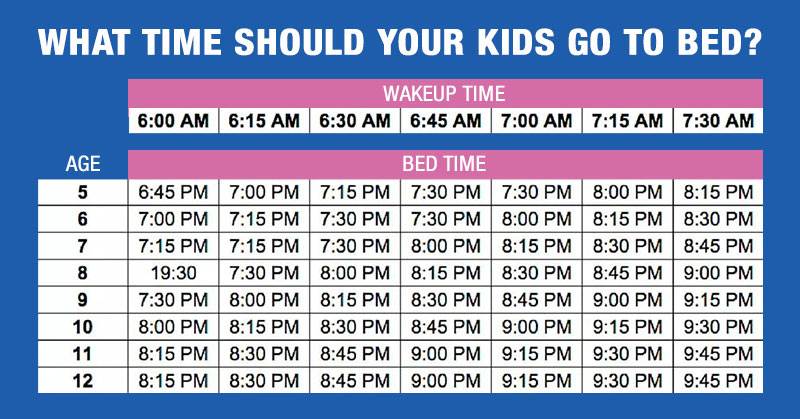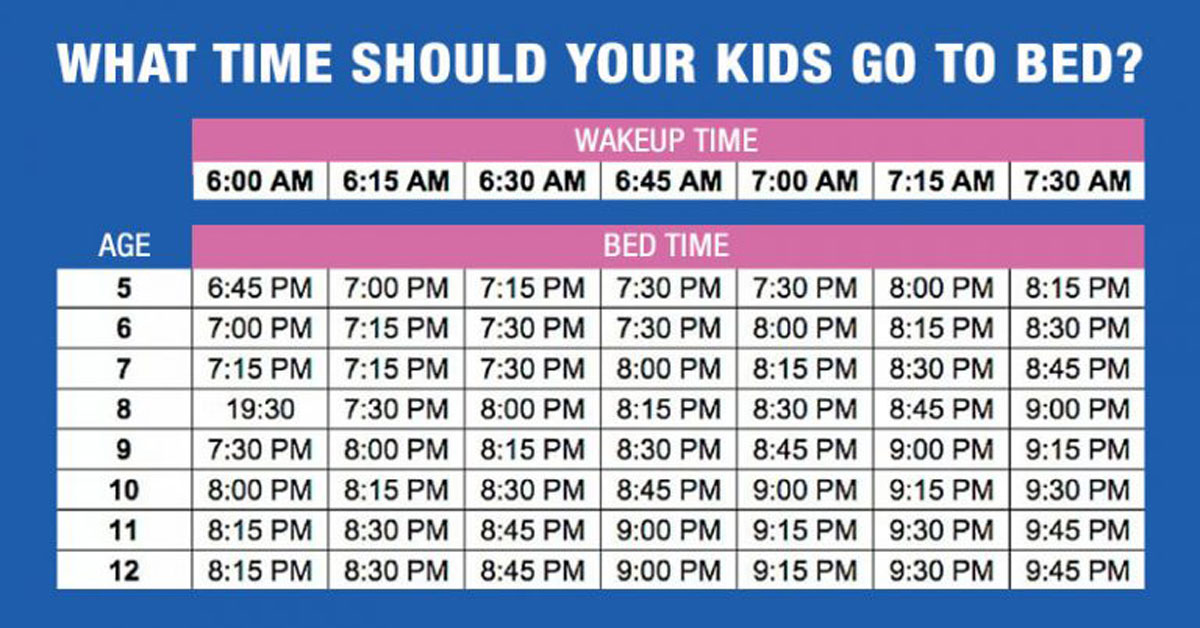For many parents, bedtime can often be a battle. Not only can it be difficult to get your child to go to bed, but it can also be a challenge to simply determine exactly when you should put them to bed in the first place. This bedtime chart is here to help!
If you try to put your kids to bed too early, they have too much energy and they’ll never settle down to go to sleep. If you leave it too late, they won’t get enough sleep, and you’ll end up with tired, cranky kids for the entire next day.
One school decided to help parents answer this question with a handy chart.

The Bedtime Chart
Wilson Elementary School in Kenosha, Wisconsin, put together a bedtime chart to help their students’ parents figure out when to put their kids to sleep. The chart is based on the age of the child, and their usual wakeup time.
The times were based on the sleep recommendations that have been determined by the American Academy of Pediatrics. For example, if a five-year-old has to get up for school at 6:30 in the morning, they should go to bed at 7:15 pm. A ten-year-old, however, who has to get up at the same time, can stay up until 8:30pm [1].
Bedtime is Important for your Kids’ Health
Adequate sleep is important for all of us, but for children, who are still rapidly growing and developing, it is even more crucial. If you are noticing that your child is performing worse than usual in school, or that their teachers are reporting more behavioral problems, you may want to consider putting them to bed earlier.
This is because a lack of sleep can make your children moodier, and decrease their cognitive ability. One study of school-age children found that when they were put to bed earlier five nights in a row, their teachers found that they were less irritable and impulsive than usual. Conversely, when they lost sleep for five nights, problem behavior worsened [2].
Several other studies have found that inadequate sleep in children is associated with decreased cognitive performance in tasks that involve learning and memory, executive function (the processes that control behavior), and processing speed [3].
Inadequate sleep can also have physical effects on your child. One study found that children who do not have a regular bedtime were twice as likely to become obese by the age of eleven than those with set bedtimes [4].
Getting your child to bed on time will have a positive impact on your health, too. At a conference organized by the Australian Sleep Foundation, researchers explained that getting kids to bed in good time may actually be more important than the amount of sleep they are getting.
“Results show children who are early-to-sleep have better health-related quality of life; and their mothers have improved mental health, compared with children who are late-to-sleep,” they said in their report [5].
Putting your kids to bed earlier gives you and your partner more time to be alone together, and will give you more time to relax without the kids making noise or demanding your attention. It may also be an opportunity to catch up on some things that you weren’t able to do earlier in the day, or do things that you can’t do when your kids are up, like read a book in the bathtub.
“So mums and dads, getting kids to bed early is not just great for them. It’s good for you too,” the researchers said. “These benefits were seen in all early-to-bed kids regardless of whether they woke early or slept late.” [5]
How Much Sleep do Kids Need?
The American Academy of Pediatrics (AAP) has published guidelines for this bedtime chart for parents as to how much sleep their child should be getting on a nightly basis:
- Ages 4-12 months: 12-16 hours (including naps)
- Ages 1-2 years: 11-14 hours (including naps)
- Ages 3-5 years: 10-13 hours (including naps)
- Age 6-12 years: 9-12 hours
- Age 13-18 years: 8-10 hours
These recommendations came from the American Academy of Sleep Medicine (AASM), and were developed by a panel of thirteen sleep experts who reviewed 864 scientific articles on the topic [6].
How to Make Bedtime Easier
For many parents, getting their kids to go to bed is often met with resistance, especially if you have multiple children that range in age. One of the most important things parents can do to help get their kids to sleep earlier is to limit screen time before bed.
The reason, according to the National Sleep Foundation, is because screens from the television, computer, and phones emit blue light that can delay the release of melatonin, the hormone responsible for making you feel sleepy [7].
This blue light can also increase alertness, and reset the body’s internal clock (also called the circadian rhythm) to a later schedule. This is particularly a problem for teens, because their circadian rhythms are already shifting naturally as they approach adulthood.
The Foundation suggests having your kids turn off all screens, including the TV, one to two hours before bedtime so their bodies can start producing more melatonin. If your older children are working late on their computer for a school assignment, it can help to dim the brightness of the screen, or to install an app that automatically warms the colors on the screen at sunset so that less blue light is being emitted [7].
They also highly recommend setting up a regular bedtime routine that remains consistent every evening. These rituals will signal your child’s brain that it is time to prepare for sleep. Warm baths, teeth brushing, and a story are calming ways to get your kid ready for bed [8].
There are other small things you can do to promote sleep, like ensuring that your child’s room is a good sleep environment. This could include decorating with soothing colors, making sure their bed is comfortable, and keeping the temperature of their room cooler at night [8].
Stick With The Bedtime Chart
You may get resistance from your child occasionally, but it is important that you remain steadfast in your commitment to ensuring your child gets adequate sleep. It will help them do better in school, they will have an improved mood, and it could even help to prevent obesity as they get older.
If nothing else, having well-rested kids will make your life easier as a parent, and putting them to bed in good time will give you some much-needed alone time.
Keep Reading: Lying down with your kids until they fall asleep is not a bad habit
Sources
- ‘This Chart Shows You When You Should Put Your Kids To Bed’ Simplemost Dave Francois. Published August 26, 2017.
- ‘Impact of Sleep Extension and Restriction on Children’s Emotional Lability and Impulsivity’ Pediatrics Reut Gruber, Jamie Cassoff, Sonia Frenette, Sabrina Wiebe and Julie Carrier. Published November 2012.
- ‘The Relationship Between Sleep and Cognition in Children Referred for Neuropsychological Evaluation: A Latent Modeling Approach’ Pubmed Adrian Svingos, Sarah Greif, Brittany Bailey, and Shelley Heaton. Published February 28, 2018.
- ‘Preschool bedtime associated with adolescent obesity’ Journal of Pediatrics Serene Yoong, PhD. Published January 1, 2017.
- ‘Study: Get Kids To bed Early’ Journal of Pediatrics Janet Doyle. Published October 23, 2015.
- ‘AAP endorses new recommendations on sleep times’ AAP News And Journals Melissa Jenco. Published June 13, 2016.
- ‘How Blue Light Affects Kids’ Sleep’ Sleep Foundation Alexa Fry. Published January 22, 2021
- ‘Research Shows That Regular Bedtimes And Mealtimes Reduce The Risk Of Childhood Obesity’ Simplemost Tricia Goss. Published

